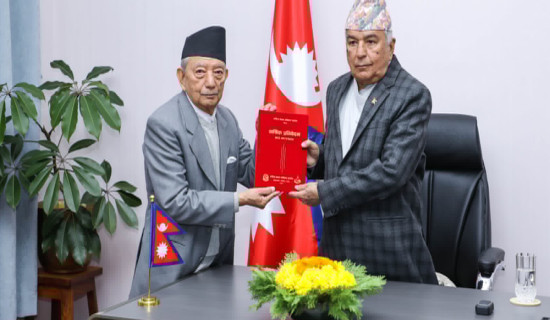- Sunday, 7 December 2025
Nepal’s Foreign Policy Diversification
A country's foreign policy is shaped and guided by multiple internal and external dynamics. The national interest is the prime factor that influences and determines foreign policy goals and priorities. The national interests, too, are determined by certain factors including geography, economy, demography, cultures, and behaviour of neighbours, values and overall geopolitical dynamics. But geography is the key determinant in shaping national interest and foreign policy priorities. Geography is permanent while other dynamics are changeable depending upon time, context and circumstances.
According to Tim Marshall, all countries are prisoners of geography. Marshall, in his famous book, ‘Power of Geography’, says, ‘geography is a key factor shaping what humanity can and cannot do’. Countries are like individuals and the relationship between countries is also like human relations, which are determined by multiple factors. It is said that the border is the starting point of a country’s foreign relations. Geography determines and limits our foreign policy choices and priorities. Let us imagine what would have been Nepal’s foreign policy or strategic construct if the Himalayas had been in the south along the Nepal-India border? Or what would have been Nepal’s foreign policy if it had been an island or coastal state? Nepal’s foreign policy is thus dictated by its geographical location, from which it cannot escape.
Territorial integrity
Sovereignty and territorial integrity are the most fundamental factors for all countries. Safeguarding sovereignty and territorial integrity is the principal goal of national interest of all countries and no country ever compromises its sovereignty and territorial integrity. Nepal’s constitution, too, has spelt out its national interest. The constitution states that the foreign policy objective of Nepal is to safeguard its national interests. Article 5 of the Constitution states, “safeguarding freedom, sovereignty, territorial integrity, nationality, independence and dignity of Nepal, rights of Nepali people, border security, economic wellbeing and prosperity shall be the basic elements of the national interest of Nepal”.
Accordingly, Nepal’s foreign policy goals and priorities are defined as being guided by the objective of promoting the country’s dignity through safeguarding sovereignty, territorial integrity, independence, ensuring economic prosperity and contributing to global peace, harmony and security. Nepal, right from its inception as a sovereign state, continues to manage international relations and foreign policy, reckoning with its geographical position. Nepal has remained sandwiched between two big powers in the south and north throughout history.
Both the southern and northern powers almost always happened to be rivals and competitors. China was ruled by different imperial dynasties until it was declared a republic in 1912. Similarly, India, too, saw different dynasties of rulers in different intervals of history. India attained independence from British colonial rule in 1947, while the People’s Republic of China was established in 1949. These two events also had a big and significant impact on the politics and state affairs in the neighbourhood.
Nepal’s geographical position as a landlocked country squeezed between two competing powers has limited its foreign policy choices and also posed a challenge to balance its relations with the two big neighbours. Right from the time when Nepal emerged as a state, its policy has been the quest for what Leo E Rose said ‘a strategy for survival’ between these two powers. Balancing between these two asymmetric powers is not the choice but a compulsion and a hard reality.
Nepal emerged as a modern country in mid mid-seventeenth century. Prithivi Narayan Shah, ruler of a tiny mountainous kingdom of Gorkha, enlarged his Gorkha kingdom, conquering several other tiny principalities and renaming the unified kingdom as Nepal. This is how Prithivi Narayan Shah laid the foundation of modern and unified Nepal. His successors gave continuity to the unification campaign but it came to an abrupt and permanent halt in 1816 when the Sugauli Treaty was signed with British India following the Anglo-Nepal War. The Sugauli Treaty not only brought a permanent halt to Nepal’s expansionary drive but Nepal also lost almost 40 per cent of its territory.
Prithivi Narayan Shah is believed to be an architect of Nepal’s foreign policy too. In his ‘Divyopadesh’ (wise counsel), Prithivi Narayan Shah likened Nepal to a yam between two boulders -- India and China. His suggestion was to deal with the two neighbouring powers carefully and not to lean too close to any of the two powers but to adopt a balanced policy with both neighbours. This can be termed as the early foundation of non-aligned policy.
Nepal did not define its foreign policy as such until the 1950s. Rulers who came to power after Prithivi Narayan Shah failed to follow his wise counsel in foreign policy and on other fronts. They instead sought to align the country’s foreign policy with that of their interests rather than the country’s broader well-being. Moreover, the royal court of Nepal suffered badly from an ugly family feud, which was reflected in its external handling as well. As a result, Nepal’s national dignity was hurt in certain cases that culminated in the ‘kot parva’ (court carnage). The period until the late 1940s, to a large extent, appeared to be the period of a kind of national capitulation in foreign policy in which the Rana rulers of that time chose to protect their power with support from the British colonial powers in India.
Diplomatic relations
However, things started to change from the later part of the 1940s. The British colonial power was preparing to withdraw, ensuring India’s independence and the leaders of the independent movement were preparing to take over the power of India in 1947. Both the British colonial rulers and Indian leaders were debating the fate of the different princely states of what used to be British India. Until then, Nepal had diplomatic relations only with Britain. The Rana rulers hastened to establish diplomatic relations with the United States on April 25, 1947, earlier than India formally gained independence.
India is the third country with which Nepal established diplomatic relations on June 13, 1947, almost two and a half months after Nepal and the USA formally entered into diplomatic relations. France is the fourth country Nepal established diplomatic relations in 1949. Nepal saw a political change in 1951 with a popular uprising that overthrew the Rana family oligarchy and established democracy. This marked the rise of a new era in Nepal’s political history that also saw steady diversification in the foreign policy domain. Now Nepal has diplomatic relations with 182 countries and has a presence in multiple regional and multilateral organisations, which is a matter of success of our foreign policy.
(The author is a former chief editor of this daily and a former ambassador. lamsalyubanath@gmail.com)









-original-thumb.jpg)






